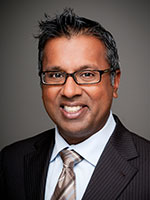MOC Tip of the Month
Dr. Viren Naik, FRCPC
How I turned my regulator review into MOC credits


When I found out that the College of Physicians and Surgeons of Ontario (CPSO) was going to review my practice, I was apprehensive, as most people are. I took a deep breath and recognized that it’s natural to feel nervous about being assessed, particularly by a regulatory authority. After 15 years in practice, this would be my first review with the regulator and I wasn’t quite sure what to expect.
After having gone through it, I can honestly say the experience was quite constructive and positive! I also found several opportunities for MOC learning that I wish to share in case you, too, ever undergo a regulator review. My peer assessor was friendly and constructive, which encouraged me to see the review as a learning and coaching opportunity. I also had the support of my medical affairs department, which was aware of these mandated regulator activities and helped me assemble all the material necessary for the review.
I realized I was not alone in this process. And neither are you!
Want to know more? If you are about to go through a medical regulatory review and would like some peer-to-peer guidance, contact me! I would be happy to chat.
Tip #1: Before the review, use it as a reflection opportunity for your CPD activities
For many specialties, including mine (Anesthesiology), the regulator will review a sample of your patient charts as part of the process. This is because there is a correlation between chart review and clinical performance. Opening up your charts to someone else can feel awkward, but it’s actually a great opportunity to engage in reflection and learning.
For example, it had been years since I had thought about my clinical scope of practice (to whom I deliver anesthesia and where). I reflected on whether it had changed over the years. Who was I treating now and where?
After preparing and reviewing my chart sample for the CPSO, I concluded that although I started my career treating complex cardiovascular patients, over the years my practice had changed to a more general focus. I recognized the spread of my anesthetic delivery to patients in General Surgery, Orthopedics, Urology, and Obstetrics and Gynecology in a tertiary care centre. Having this information helped me reflect on gaps in my CPD goals. Specifically, it guided me to balance my CPD plans proportionally between my non-clinical interests/time and my clinical responsibilities. For example, if 40 per cent of my practice is dedicated to the delivery of clinical service, then I should rebalance my planned CPD activities so that 40 per cent is focused on learning the most current advances relevant to the areas where I deliver anesthetics.
Tip #2: During your review, reflect on the quality-improvement opportunities revealed in your data and feedback for Section 3 credits
At the beginning of this process, I was really focused on the review itself (sitting with the assessor to review the summary and discuss the feedback). However, I realized that valuable learning was embedded at every stage — from preparing my sample, to reading the assessor’s report, to reflecting on the ensuing impact on my practice and CPD plan. The actual review might have seemed like the catalyst, but the change process actually started before I met the assessor and continued well after we met.
I learned that the way I chart affects quality improvement measures not just at the individual level, but also at the specialty, institution and system levels. For example, I discovered it’s important for anesthesiologists to document patient demographics, such as height and weight, for every anesthetic (even an estimate for emergency cases). It’s also necessary to comment on blood loss, even minimal amounts, regardless of the complexity of the surgery. Apparently the anesthesia record is considered the most accurate reflection of blood loss in the chart. It’s studied by quality-improvement researchers to address system issues, such as how to reduce blood loss following different surgeries. Although I only used to record blood loss for major cases, I now record even a few drops.
Feedback from my review also made me decide I would add a narrative history and physical to all of my electronic records from now on. In an anesthesia record (paper or electronic), there’s a tendency to simply tick off boxes. However, a narrative not only enhances the anesthesia record for a regulator review, it also provides meaningful context for other practitioners and institutions when the inevitable handover takes place.
Record the process and outcomes for Section 3: Claim the time spent collecting data, receiving feedback, reviewing the feedback report, reflecting on the information and deciding on changes to your practice under Section 3 Practice Assessment for three credits per hour.
Tip #3: After your review, make it a group learning opportunity
If you have gone through one of these reviews, consider sharing what you have learned as an educational opportunity for the entire department and team. Ask your department chief if you can present some tips to guide best practices for your team going forward. For example, I will recommend to my colleagues at The Ottawa Hospital to record all blood loss, even if it’s just a thimbleful! In sharing my learnings, I can support their CPD and help them to pursue some quality improvement of their own, all in the interest of better patient care.
Claim post-review MOC opportunities: All the specialists with whom you shared your tips in a group-learning activity can claim what they learned for Section 1 credit.
Share "what works" for you!
Big or small, we'd love to hear your MOC tip. Submit a tip through our online form. If we use it, we'll send it to our 40,000+ members in an upcoming issue of Dialogue (attributed to you). We'll also post it on our website where it can be searched and read by all our MOC Program participants.
What people are saying about MOC tips
“Thank you for your MOC Tip of the Month. I very much enjoyed it and used it to create a template for developing a PLP. As the CPD Chair for the Canadian Society of Otolaryngology-Head and Neck Surgery, I am trying to assist our members in their CPD activities. We will use the template at our annual meeting this year for both the accredited and non-accredited educational activities.” — Gigi Osler, MD, FRCSC, 2017 President-Elect of the Canadian Medical Association
“I received several positive comments about my PLP tip. People felt the steps were helpful with the use of the personal example. In fact, one person is planning to attend a course on Indigenous health!” — Shahid Ahmed, MD, FRCPC, MOC tip author